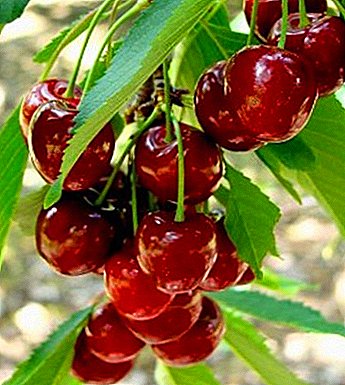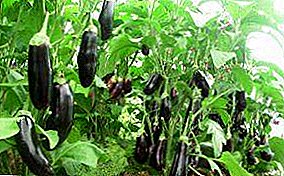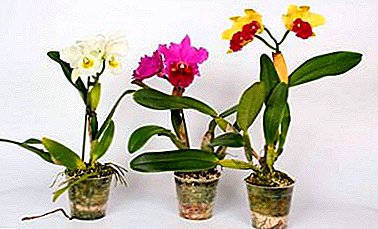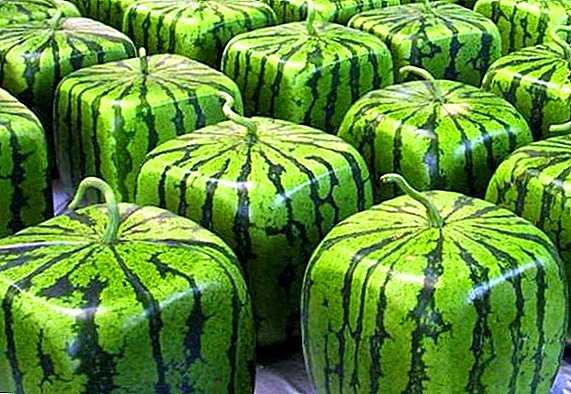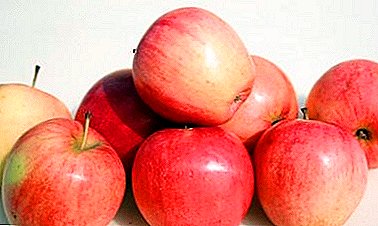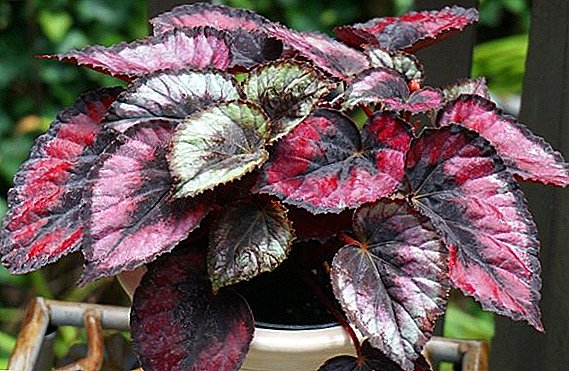 Begonia is popular among gardeners, due to the large selection of shapes and colors of leaves and flowering. In addition, the plant is easy to grow at home. The article is devoted to the subtleties of indoor cultivation of decorative and leafy species of begonia.
Begonia is popular among gardeners, due to the large selection of shapes and colors of leaves and flowering. In addition, the plant is easy to grow at home. The article is devoted to the subtleties of indoor cultivation of decorative and leafy species of begonia.
Description of indoor plants
Most decorative begonias grow in the form of a lush bush, but there are also varieties that look like trees. In height they grow from 15 cm to 1 m. The variety is valued for its beautiful leaves. They are different in shape - rounded and cut, twisted into a spiral and with carved edges. Often resemble the elephant ear.  Diverse and colored leaves - can be monochromatic and combine 2-3 colors each, have green, red, white, silver, brown shades. There are varieties with spotty leaves, smooth and covered with hairs. The decorative begonia has deciduous flowering.
Diverse and colored leaves - can be monochromatic and combine 2-3 colors each, have green, red, white, silver, brown shades. There are varieties with spotty leaves, smooth and covered with hairs. The decorative begonia has deciduous flowering.
The variety is more suitable for gardening apartments, houses, offices, winter gardens, balconies, terraces. It can grow both alone and as part of a flower arrangement. Today displayed many varieties of decorative begonia.
Did you know? Begonia is named after a man who has never seen her in her life. The first botanist from France, Charles Plumier, found several species of a flower in the Antilles. The plant scientist called by the name of his friend, French quartermaster Michel Begon.
The most popular ones are:
- Royal;

- Diadem;

- Spotty;

- Griffin;

- The imperial;
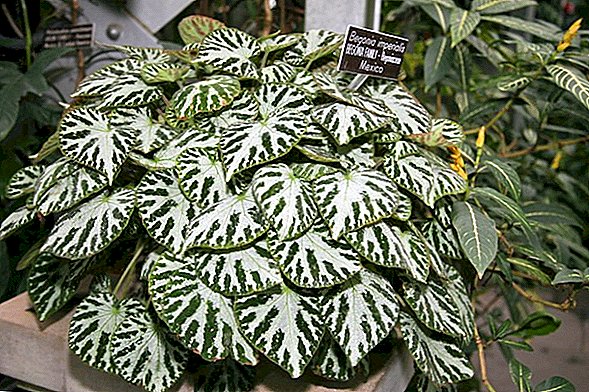
- Mason;
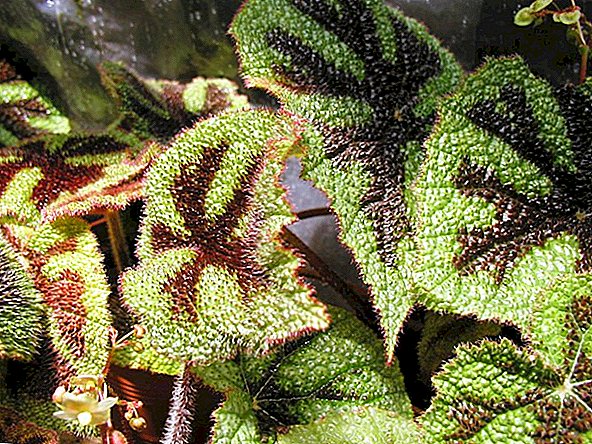
- Griffith.
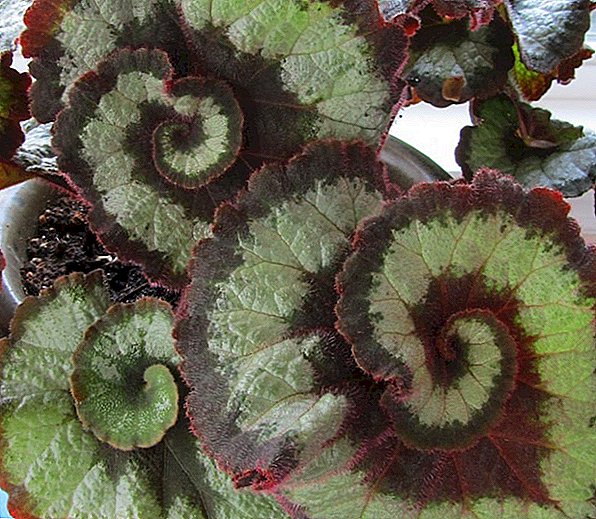
Conditions for growing at home
To reveal the beauty of foliage of begonia as much as possible, it is necessary to create favorable conditions for it in the form of good lighting, moderate heat and high humidity.
Location and lighting
For this indoor plant you need bright light with shading from direct sunlight and a long light day for 11-15 hours. It is recommended to grow begonia on the southeast and southwest windowsills.
The north is too dark for a flower. When the content of begonias on the southern windowsill requires the dispersion of sunlight. In winter, it is recommended to install additional lighting with fluorescent lamps.
Did you know? In the city of Rochefort (France) in 1986 opened the Begonias Orangery, the largest collection of flowers in Europe, numbering 400 species and 900 hybrids, whose bushes reached heights from 5 cm to 5 m.
Temperature conditions
Ideal temperature parameters for decorative leafy culture throughout the year are + 20… + 25 ° С. The flower tolerates a short decrease in temperature to + 16 ... + 18 ° С. Growing at a lower temperature for the plant is detrimental.
Air humidity
In the room where begonia grows, you need to maintain humidity at the level of 50-65%. When the air is too dry, the ends of the leaves are drying out and the spider mite infects. If the humidity is too high, the root system may rot.  In spring and summer the plant can be sprayed. You can install the pot on a tray with moistened pebbles or expanded clay, as well as humidify the air with a special humidifier. Spraying is prohibited in winter.
In spring and summer the plant can be sprayed. You can install the pot on a tray with moistened pebbles or expanded clay, as well as humidify the air with a special humidifier. Spraying is prohibited in winter.
Pot selection
The pot for planting begonias pick up shallow and wide. It is better to grow a flower in plastic containers. However, ceramic vessels also fit. The main thing is that the bottom had drainage holes for the discharge of excess moisture.
Home care
Begonia requires minimal care. It will include watering, spraying in the spring and summer, fertilizing during the growing season, pruning and transplanting.
Important! Do not be afraid, if within 1-2 months after transplantation begonia stops in growth. So she reacts to stress because of the changed conditions of growth.
Top dressing
During the growing season it is recommended to fertilize begonia. This will increase its decorativeness, activates growth and strengthen the immune system. The best way to feed is alternately applying organic matter and mineral fertilizers. The recommended frequency is 1 time in 2-3 weeks. In the store you can purchase compositions that are designed specifically for begonias of the same name.  Also suitable universal fertilizers, for example, "Kemira-universal" or those that are designed for azaleas. From October to February, feeding is stopped. At this time, the plant is at rest, and therefore, it does not need to be disturbed.
Also suitable universal fertilizers, for example, "Kemira-universal" or those that are designed for azaleas. From October to February, feeding is stopped. At this time, the plant is at rest, and therefore, it does not need to be disturbed.
Watering features
Watering for begonias requires moderate. It reacts equally badly to the stagnation of moisture and its lack. As with the wetting of other indoor plants, they are guided by the state of the soil. Each subsequent watering is done when the top layer of the earth dries out. It is necessary to water plentifully, under a root. After the excess water flows into the pan, it must be drained.
Important! During watering, it is necessary to ensure that the drops do not fall on the trunk, shoots and foliage. Ignoring this rule leads to the formation of ugly spots and burns.
In winter, watering should be reduced - after drying the upper ground layer, wait another 1-2 days. Use soft tap water at room temperature. It should be passed through a filter that removes chlorine and impurities, or be defended for 1-2 days.
How to trim and replant?
Formed pruning begonia does not need. In the spring, before transplantation, should be cut long, old shoots. In the future, they can be used as cuttings for reproduction. Dry leaves and buds are removed as needed. Transplantation of young plants should be carried out annually in early spring. Plants that have reached 4 years old are allowed to replant 1 time in 2-3 years.  Soil for planting can be purchased at the store. Compounds designed for decorative leafy houseplants should be chosen. They must be fertile, loose, with good moisture and air conduction, neutral or slightly alkaline pH. Also, the soil substrate can be prepared with your own hands at home.
Soil for planting can be purchased at the store. Compounds designed for decorative leafy houseplants should be chosen. They must be fertile, loose, with good moisture and air conduction, neutral or slightly alkaline pH. Also, the soil substrate can be prepared with your own hands at home.
To do this, you will need to mix leaf soil with humus and sand, to which add a small amount of vermiculite or perlite. The mixture, prepared by himself, should be disinfected. For this, it is boiled, aged over steam, in an oven, microwave, or poured over with a solution of manganese.
Learn more about how to properly transplant indoor plants.
To properly transplant a plant, you must:
- Rinse the pot with boiling water and dry well.
- Place a drainage layer at a height of 1 / 3-1 / 4 of the entire tank at its bottom. As the drainage is used expanded clay, brick chips.
- Sprinkle with a thin layer of soil.
- Remove the plant from the old pot.
- Clean the root system from the ground.
- Set the bush in the center of the new tank.
- Evenly distribute the root system.
- Sprinkle voids with soil, leaving 1.5-2 cm from the edge of the pot.
- Lightly seal with palms.
- Liberally pour.
- After 20 minutes, remove excess water from the pan.
Video: transplanting begonias decorative and hardwood
Breeding methods
Begonia is propagated in four ways:
- Cuttings.
- The division of the bush.
- The division of the sheet.
- Seeds.
Breeding plan for the first half of spring.
Cuttings
The easiest and most common way of breeding begonias at home. For it use a healthy large leaf with a handle. After cutting, the end of the cutting is treated with crushed activated carbon, and then placed in a container filled with a mixture of leafy soil, peat and sand (in equal parts) for rooting.  Root can also be simply in the water, which must be periodically changed. As necessary, the cuttings are watered. About a month later, roots and young leaves should appear on the cuttings. After that, they can be transplanted to a permanent place.
Root can also be simply in the water, which must be periodically changed. As necessary, the cuttings are watered. About a month later, roots and young leaves should appear on the cuttings. After that, they can be transplanted to a permanent place.
Seed
Seed houseplant rarely propagated. This is a troublesome and lengthy process. More often, it is resorted to only by professionals who wish to preserve the varietal qualities of the parent plant. The main difficulty of this method is that the seeds of the flower are very small. They are difficult to collect and sow. Before planting, they must be processed - soak, harden, and sustain in a growth promoter.
Did you know? In 1988, in honor of the friendship between Japan and China, the begonia variety was bred, which is named after the Chinese leader - kimcheniriya. Every year he releases flowers on February 16, the day Kim Jong Il was born.
Seeds are sown on the surface of the soil mixture of leaf, turf soil, peat and sand. Deepen lightly, then moistened with an atomizer, covered with glass or film and placed in a room where the temperature is maintained at + 22 ... + 25 ° С. Landings are regularly aired and moistened as needed.  As soon as sprouts appear, the shelter is removed. When forming two leaves, shoots dive into separate containers. When young plants will have 5-6 leaves and a strong root system, they are planted in permanent pots.
As soon as sprouts appear, the shelter is removed. When forming two leaves, shoots dive into separate containers. When young plants will have 5-6 leaves and a strong root system, they are planted in permanent pots.
Sheet division
By dividing the leaf, not all species and varieties of begonias can be propagated, but only those whose leaves have distinct veins and are pubescent on the underside.
This method is produced as follows:
- Cut a large healthy fleshy leaf.
- Cut it into several parts in the form of triangles so that at least one piece remains in each fragment.
- Triangles are planted cut down into containers filled with soil mixture or sand.
- The containers are covered with glass or plastic containers.
- Airing is carried out daily.
They can be planted in a pot after 3 months.
Video: reproduction of the ornamental foliage begonia by leaf division
Dividing bush
In this way, the plant is propagated during transplantation. The shrub is cut with a sharp disinfected knife into 2 or 3 parts so that each of them remains with approximately the same number of roots. Slices cut with crushed activated carbon. Then each part is planted in a separate pot filled with the recommended soil mixture for planting. 
Diseases and pests
If the owner of the flower makes mistakes in the care or did not take care of creating comfortable conditions for its growth, the plant can suffer from diseases and attacks of harmful insects.
Of the diseases of begonias more often threaten:
- Mealy dew. It develops when there is no airing for a long time in the room where the flower grows, as a result of which air stagnates, as well as during sudden changes in temperature and excessive moisture. The fact that the plant is infected, can be recognized by the characteristic white bloom on the foliage, which is as if covered with flour. Treatment should begin in the early stages of disease detection. The plant needs to be isolated and processed with "Topaz", "Home", "Early", "Tiovit". Additionally, you can use traditional methods, for example, wiping soda solution (5 g per 1 liter of water).
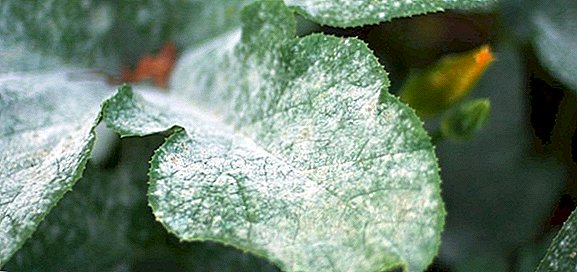
- Gray rot. If the humidity is too high, too humid, cold temperatures and no fresh air is present, plant organs can become rotten. The leaves are covered with gray spots, the roots - gray. Treatment consists of treatments with "Teldor", "Switche EDC", "Horus EDC". For prophylaxis use spraying "Fundazol", "Topsin-M".
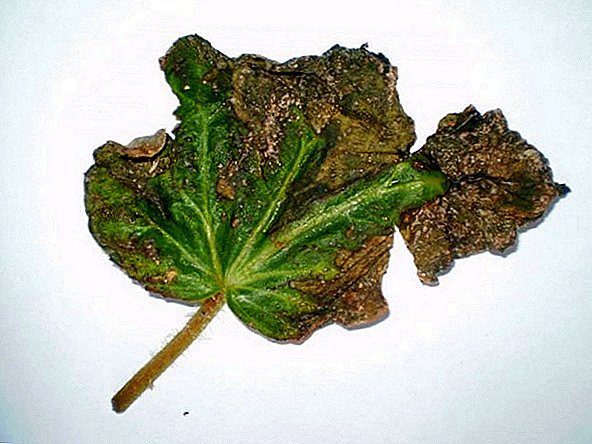
Begonias can attack such insects:
- Aphid. Detect the presence of this insect can be under the leaves. This is a very small parasite that drinks juices from the plant and leads to yellowing of the leaves, their wilting and falling off. With minor infection, aphid is destroyed by rubbing with soapy water. If the pest massively attacked the plant, it is treated with "Akarin", "Inta-Vir", "Fufanon", "Fitoverm", "Aktara".
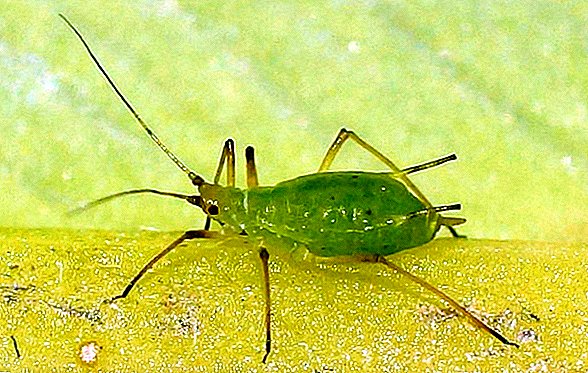
- Spider mite It settles on those plants that grow in conditions of low humidity and cold temperatures. This parasite is a small, sucking red or black insect. In the process of life leaves the web on the leaves, stalks and shoots. In order to expel the tick, it is necessary to increase the humidity of the air and make Appolo, Borneo, Flumate treatment.

- Shchitovka and false shield. Drinks juice from the flower. The appearance indicates the formation of brown spots on the foliage. Treat the plant by wiping with a soap-alcohol solution (mix liquid soap (15 g), denatured alcohol (10 ml), water (1 l)), spraying "Aktellik", "Phosbecid", "Aktar".
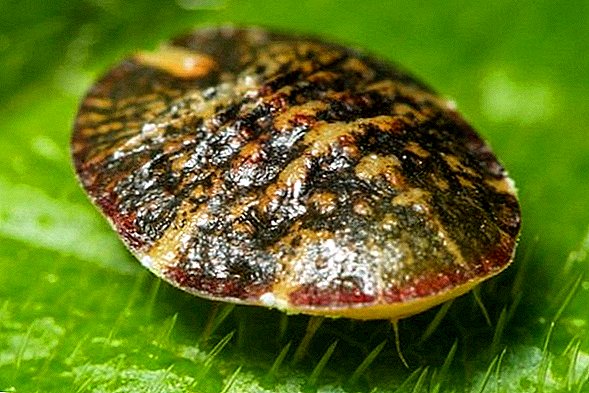
- Nematode. Begonia affects several species of nematodes that damage leaves, stems and roots. To cure the plant from this pest is impossible. When it is found, the flower should be thrown away along with the ground and the pot.
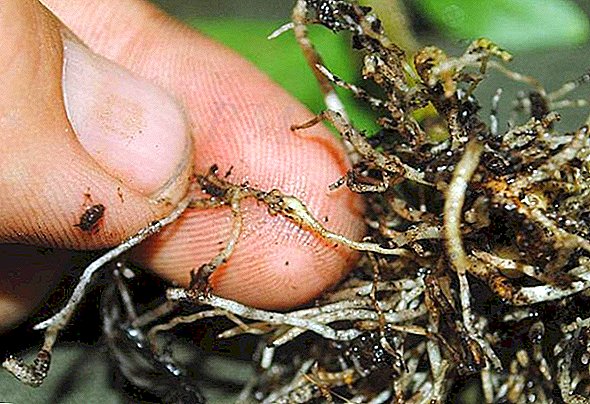
The advantages of the content of the decorative and leafy begonia in the apartment is the decorativeness of the leaves, simple care and reproduction, undemanding to create a special microclimate. This flower is able to decorate any interior, create comfort in the room and clean the air from harmful substances.















